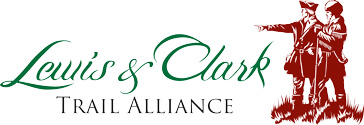I have always held it a crime to anticipate evils I will believe it a good comfortable road untill I am compelled to beleive differently.—Meriwether Lewis, May 26, 1805
The bulk of Mr. Wilson’s career was spent in the Museum and Archives field where, over the years, he did everything from exhibition design and education programming to artifact care and archival storage and retrieval. He quickly learned that the only people who will ever be remembered are those who wrote it down—something relevant to all Lewis and Clark fans.
Since 2011, Wayne has teamed with various crews to do long distance wilderness canoe trips—in 26′ voyageur canoes that hold six people. These wonderful set of adventures have taken him down the MacKenzie River in Canada’s Arctic to the Yellowstone River in Montana.
While Wayne has been sketching and painting since high school, it was not until his first paddle trip in 2011 that he started keeping what you would call a ‘Travel Journal’. Watercolors from his Columbia, Missouri, and Yellowstone travel journals are featured here at the Discovering Lewis & Clark website. Other watercolors are used too—especially on our home page.
You can find more of his art and learn about his travel journal course at www.waynewilsonart.com.
Articles with Wayne’s Art
June 18, 1804
New ropes and oars

At Rope Walk Camp near present-day Waverly, Missouri, the hunters kill five deer and a bear. The men coat themselves with bear grease to deter the mosquitoes and finish 600 feet of new rope and 20 new oars.
July 24, 1806
Pryor's mission begins

Clark’s group paddles 70 miles down the Yellowstone while Sgt. Pryor leaves for the Knife River Villages with the horses. Lewis remains at Camp Disappointment and at the Great Falls, the portage continues.
Common Chokecherry
Prunus virginiana
by Kristopher K. Townsend
As they traveled up the Missouri in the summer of 1804, the journalists took note of a wild cherry different than the wild cherry of their homes. It was the common chokecherry, which grew on bushes instead of trees.
October 21, 1805
Columbia River rapids

Moving down the Columbia above present John Day Dam, the paddlers navigate several rapids while the non-swimmers walk around them. Pvt. Collins shares his camas-brewed beer, and Mt. Hood is in view.
Black Chokecherry
Prunus virginiana var. melanocarpa
by Kristopher K. Townsend
This variety of the common chokecherry gave Lewis his decoction of simples and was the subject of his botanical scrutiny.
Serviceberry
Amelanchier alnifolia
by Kristopher K. Townsend
Everybody liked the abundant serviceberry fruit—the Lemhi Shoshones were living on them, the enlisted men “regaled themselves,” and Lewis was the first to collect a specimen for science.
Experience the Lewis and Clark Trail
The Lewis and Clark Trail Experience—our sister site at lewisandclark.travel—connects the world to people and places on the Lewis and Clark Trail.
Discover More
- The Lewis and Clark Expedition: Day by Day by Gary E. Moulton (University of Nebraska Press, 2018). The story in prose, 14 May 1804–23 September 1806.
- The Lewis and Clark Journals: An American Epic of Discovery (abridged) by Gary E. Moulton (University of Nebraska Press, 2003). Selected journal excerpts, 14 May 1804–23 September 1806.
- The Lewis and Clark Journals. by Gary E. Moulton (University of Nebraska Press, 1983–2001). The complete story in 13 volumes.



